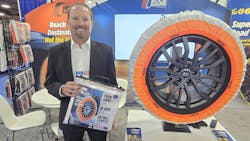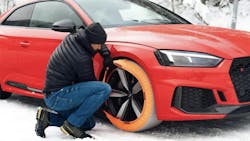Tire socks pick up traction in U.S. market with debut of ISSE textile chains
LAS VEGAS—Longtime entrepreneur and chief executive Bart Plaumann, who grew up in Buffalo, knows a thing or two about driving in the snow. That’s why, after seeing how popular they are in Europe, he immediately knew that tire socks, a popular emergency snow device in Europe, could have a similar impact stateside.
For starters, the fabric tire covers are easier to install than tire chains and provide similar traction in ice and snow up to 6 inches. They take a few minutes to put on each drive tire, while tire chains can take more than 30 minutes. They are also 80% lighter and, unlike chains, cover the entire drive tire for consistent grip. On the cost side, a set of two for a truck runs under $200, lower than many metal tire chain options, which are also prone to rust and corrosion.
For more on winter trucking:
Plaumann, who previously ran Pylon, a manufacturer that licenses wiper blades to Michelin, began conversations with ISSE, a leading tire sock manufacturer out of Barcelona, to bring their tire socks to America. ISSE reported that three years ago, tire chains had a 70% market share in Europe and Japan; now tire socks own a 70% share.
Fleet Maintenance ran into Plaumann, who last March became CEO of ISSE North America, at the 2025 Automotive Aftermarket Products Expo (AAPEX), where the company launched its North American line of textile traction devices—with the hope North Americans will also hop to socks.
ISSE's Tire Socks
ISSE offers two different kinds of tire socks, Super and Classic, available in sets of two for both cars and trucks. Super “has a little bit more of an intensity in the fabric” than the Classic, Plaumann said, and is three times thicker.
Both use tribologic ACTIV3D braiding engineered for friction and water exposure to provide improved traction on ice and snow. They absorb moisture as the sock hits the road, and then expel it as the tire turns. They are manufactured with a proprietary filament that’s eight times stronger than iron and should last up to 150 miles, the company said.
Drivers, though, should not go above 30 mph while using tire socks (also the recommended max speed for tire chains). They come in six different sizes and are available for Class 8 trucks.
Goodyear also sells the socks as Goodyear Grip and Goodyear Pro under its own brand.
Winter trunk essential?
Plaumann also made a case that ISSE’s tire socks deserve a place in both car and commercial vehicle emergency roadside kits, noting that winter accounts for nearly a quarter more non-fatal accidents than the three other seasons. This leads to “a lot of anxiety” for drivers, he reasoned, adding that, “A lot of people don't want to go drive in the winter because of that."
Commercial drivers don’t have much choice in that matter, and when a winter storm hits, snow socks could provide peace of mind for fleet managers and reduce ice-related fender benders. For last-mile vehicles that make frequent stops, this could also be a quick emergency solution to finish a route and get back to homebase.
Plaumann offered it as an even more valuable tool for your most precious cargo.
“I want this for my daughter in her car, even though she may never use it,” he said. “I want her to have that type of security.”
The washable socks can be stored flat in a trunk, taking up far less space than low-tech solutions such as kitty litter and a shovel, and are easy enough to install for first-time drivers.
This doesn’t mean winter drivers should be complacent even when using them.
“You still have to be aware of the conditions you're in and drive appropriately,” the CEO cautioned.
Socks vs. chains
It remains to be seen whether tire socks will have the same market penetration in the United States as in Europe and Japan. Several states have tire chain laws for commercial vehicles. For example, commercial vehicle operators (GVWR >16,000 lb.) in Colorado risk a fine if they are caught without carrying tire chains or approved alternate traction devices from Septeber through May.
As for whether ISSE will work to get its socks approved, Plaumann said the company hadn’t fully considered it yet, instead focusing on its launch.
“What I can tell you is we do have the certifications from each state, so we already have contacts,” he added.
But the CEO also noted that while tire socks have a lot of benefits, tire chains are better for deep snow. “But we're working on another product that I should have before the show next year that addresses that in a better way,” Plaumann concluded.
He also mused that at some point, ISSE may sell more fashionable socks; someone previously suggested a leopard print to appeal to female drivers.
About the Author

John Hitch
Editor-in-chief, Fleet Maintenance
John Hitch is the award-winning editor-in-chief of Fleet Maintenance, where his mission is to provide maintenance leaders and technicians with the the latest information on tools, strategies, and best practices to keep their fleets' commercial vehicles moving.
He is based out of Cleveland, Ohio, and has worked in the B2B journalism space for more than a decade. Hitch was previously senior editor for FleetOwner and before that was technology editor for IndustryWeek and and managing editor of New Equipment Digest.
Hitch graduated from Kent State University and was editor of the student magazine The Burr in 2009.
The former sonar technician served honorably aboard the fast-attack submarine USS Oklahoma City (SSN-723), where he participated in counter-drug ops, an under-ice expedition, and other missions he's not allowed to talk about for several more decades.

